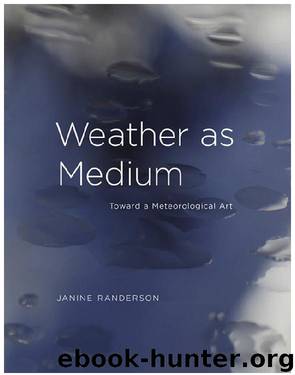Weather As Medium by Janine Randerson

Author:Janine Randerson
Language: eng
Format: epub
Tags: art and science; art-science collaboration; environmental art; atmosphere; weather; meteorology; participatory art; Anthropocene; climate change; data visualization; digital art; eco-politics; eco-aesthetics; contemporary art; social art platforms; twentieth century art; Indigenous; environmental art; 1960s art; electronic art; 21st century art; art and space; art and technology; the material turn; the ecological turn; art and climate modification; post-anthropocentrism; media theory; sound art; performance art; aboriginal art
Publisher: MIT Press
Published: 2018-10-24T16:00:00+00:00
Cyclone.Soc: Information Politics
In Cyclone.Soc British artists Corby and Baily draw together the political energies surrounding the global financial crisis of 2008 and the issue of global warming in anxious synthesis. This commentary refers to the second version of Cyclone.Soc shown at MIC Toi Rerehiko in Auckland. On October 11, 2008, a week before the Auckland show opened, the head of the International Monetary Fund (IMF) warned that the world financial system was teetering on the brink of systemic meltdown. As an immediate response to this crisis, Cyclone.Soc collated the opinions of geographically dispersed sets of Internet users in political news feeds about the financial crisis. They visualized the intensifying flurry of words as moving, cyclonic weather patterns. The live text-feeds reflected the rising stress levels and conflicting responses to the growing financial crisis among web users. Online participants heatedly debated topics from defaults on subprime housing loans and the collapse of banks to the breakdown of Iceland’s financial system.
The live text on a projection screen curled into the shape of the tight isobars that signal the low-pressure system of cyclones, allowing the gallery audience to follow the growing public conversation on multiple news feeds. The isobar forms were distilled by the artists from publicly available satellite forecasts for the East Coast of the United States in autumn 2005. The storm patterns linked the climate issue to the financial system, both once assumed to be relatively stable, or at least slow to change. Now they were thrown into increasingly violent patterns in which one element threatens to destabilize the next. By streaming online news feeds, Cyclone.Soc became a lively barometer of the public mood, or a “landscape of feeling,” as Tom Corby described this work to me in a 2008 interview. The graphic text acts “as metonyms for different types of cultural and ideological tension.” The audience in the gallery could interact with a mouse to zoom in on parts of the streaming text and scroll around the black-and-white graphic atmospheric patterns.
As noted in chapter 3, information visualization is a political, regulatory tool in online networks for managing complex streams of data through design and digital cartography. The pairing of topical, emotive data sets and isobar lines forges a link between the physical world and the financial systems that has cycles of growth and recession, like the intensification of weather fronts. The 2006 version of Cyclone.Soc combined intense debates between extremist religious and political groups in the United States with the isobar lines of the cyclones at the height of the war on terror. The visualization makes tangible growing fears about the personal impacts of the crisis, together with the patterns of a severe storm that shape the superstructure of the immediate human catastrophe.
Cyclone.Soc makes the connectedness of the global financial and ecological systems apparent. The work signals that we should pay attention to the energy spend of the earth’s resources and the functioning of banks and the stock market system simultaneously. We have become proficient at describing human behavior (in relation to fossil fuel consumption) in terms of carbon credits, debits, and losses.
Download
This site does not store any files on its server. We only index and link to content provided by other sites. Please contact the content providers to delete copyright contents if any and email us, we'll remove relevant links or contents immediately.
Cecilia; Or, Memoirs of an Heiress — Volume 1 by Fanny Burney(32495)
Cecilia; Or, Memoirs of an Heiress — Volume 2 by Fanny Burney(31909)
Cecilia; Or, Memoirs of an Heiress — Volume 3 by Fanny Burney(31889)
The Great Music City by Andrea Baker(31756)
We're Going to Need More Wine by Gabrielle Union(19003)
All the Missing Girls by Megan Miranda(15773)
Pimp by Iceberg Slim(14433)
Bombshells: Glamour Girls of a Lifetime by Sullivan Steve(14020)
For the Love of Europe by Rick Steves(13556)
Talking to Strangers by Malcolm Gladwell(13290)
Norse Mythology by Gaiman Neil(13278)
Fifty Shades Freed by E L James(13185)
Mindhunter: Inside the FBI's Elite Serial Crime Unit by John E. Douglas & Mark Olshaker(9260)
Crazy Rich Asians by Kevin Kwan(9220)
The Lost Art of Listening by Michael P. Nichols(7453)
Enlightenment Now: The Case for Reason, Science, Humanism, and Progress by Steven Pinker(7272)
The Four Agreements by Don Miguel Ruiz(6698)
Bad Blood by John Carreyrou(6581)
Weapons of Math Destruction by Cathy O'Neil(6214)
